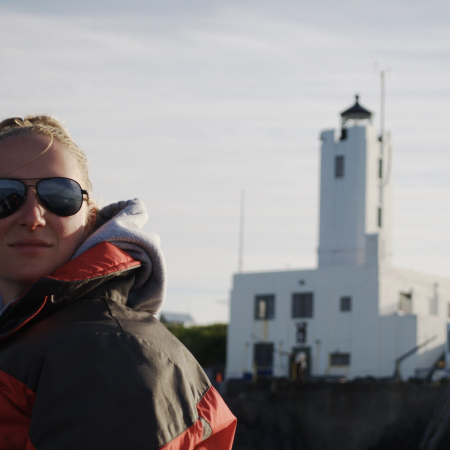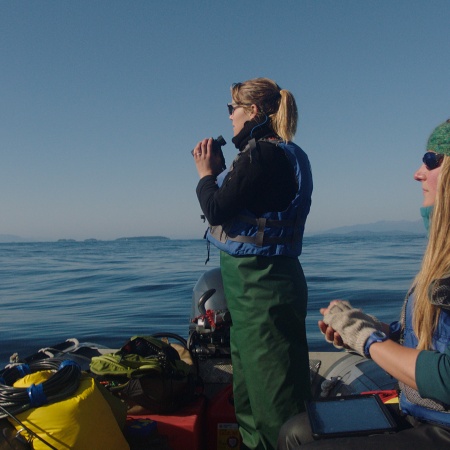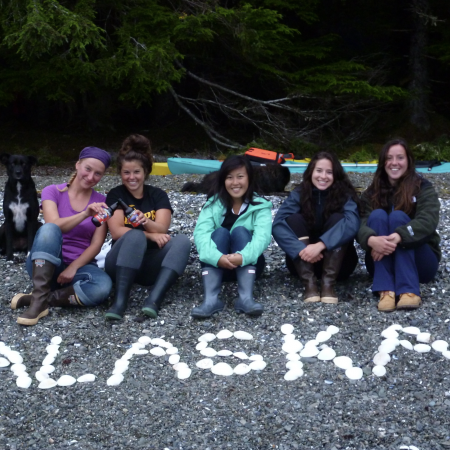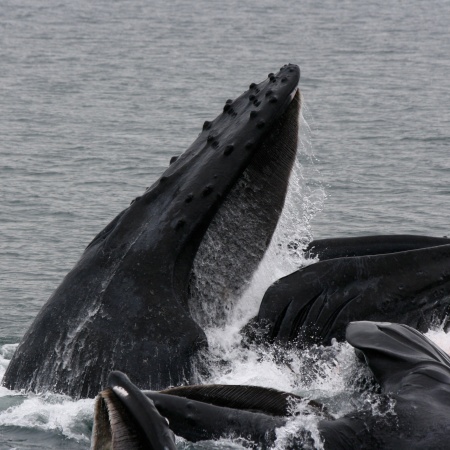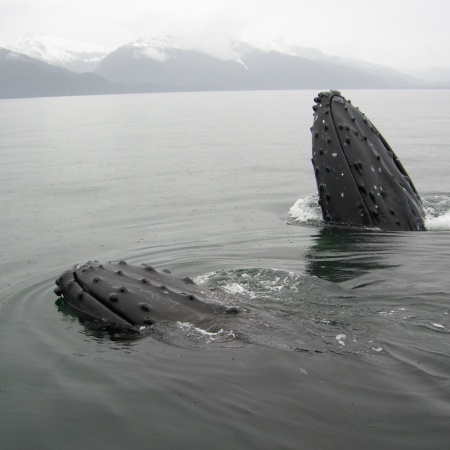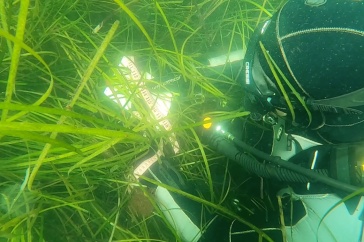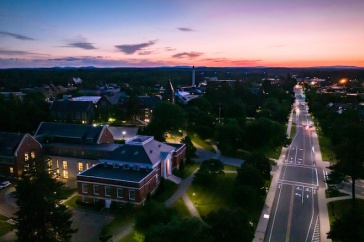Michelle Fournet still vividly recalls one of the first times she listened to humpback whales as a researcher. She was sitting in a small, 10-foot inflatable raft, bobbing on the ocean waves just off the coast of her field station at Five Finger Islands Lighthouse in Alaska, and it was raining hard. The din of the rain hitting the water’s surface made it more difficult to hear the sounds coming into her headphones from the hydrophone (an underwater microphone) lowered 25 meters into the water below her.
About the Center for Acoustics Research and Education (CARE)
![]() At the Center for Acoustics Research and Education (CARE), researchers focus on how sound on land, in air and under water can be used to monitor and assess impacts relating to national security concerns, food security, energy, environment and health. Learn more.
At the Center for Acoustics Research and Education (CARE), researchers focus on how sound on land, in air and under water can be used to monitor and assess impacts relating to national security concerns, food security, energy, environment and health. Learn more.
About the Marine Bioacoustics and Behavior Lab (“Sea BABEL”)
![]() Sea BABEL uses sound to investigate questions of ecological importance in the aquatic environment. This includes investigating how marine organisms use sound to facilitate vital life functions (animal communication), looking at the potential impact of noise and climate change on marine species (anthropogenic impacts), and researching how sound can be used as an indicator of ecosystem health (acoustic indicators). Learn more.
Sea BABEL uses sound to investigate questions of ecological importance in the aquatic environment. This includes investigating how marine organisms use sound to facilitate vital life functions (animal communication), looking at the potential impact of noise and climate change on marine species (anthropogenic impacts), and researching how sound can be used as an indicator of ecosystem health (acoustic indicators). Learn more.
"I heard a whale, … a sound that I’ve never heard before," says Fournet. "I heard a sound that perhaps had never been documented before, and I remember how exciting it was to be collecting these sounds and sharing them.
"I remember straining to really listen and hear those sounds and being so excited that it had worked — that we got out on the water, dropped a hydrophone and that we’d actually heard what we were listening for. That was very, very exciting."
That was in 2011 while working toward her master’s degree. As part of this research, Fournet built a catalog of sounds of humpback whales in Southeast Alaska. And she’s been building on that catalog ever since, using her and her colleagues’ acoustic research to better understand what humpback whales and other marine life are saying, what the function of their calls is and how they adjust their calls when the ocean gets noisier and quieter.
At UNH, Fournet serves as a visiting associate professor in the department of biological sciences at the College of Life Sciences and Agriculture; associate director for education of the Center for Acoustics Research and Education at the Institute for the Study of Earth, Oceans, and Space; and director of the UNH Marine Bioacoustics and Behavior Lab. She and bioacoustics researcher Ellen Garland of the University of St. Andrews in Scotland were featured in the recently released Apple TV+ documentary Fathom, which premiered at the Tribeca Film Festival in June 2021, followed by screenings at AFI DOCS and the Edinburgh International Film Festival.
Working on Fathom
Fathom was directed and filmed by Drew Xanthopoulos, who shot footage of Fournet in Southern Alaska in 2018 and 2019. Xanthopoulos initially approached Fournet in 2017, looking for information on marine bioacoustics and an opportunity to film some pilot footage of her research that he could use to pitch a longer documentary to potential investors. Fournet, a doctoral student at Oregon State University at the time, invited him to accompany her and her fellow researchers on a weeklong expedition to Alaska.
"By the end of that week, he basically said, 'I don’t think this is just pilot footage. I think that this story and this research question is really special,'" says Fournet.
Xanthopoulos joined Fournet on a much longer field expedition Frederick Sound in 2019, where he shot the bulk of the footage of her research that he used in Fathom. While the goal of the film was to tell a scientific story and to show biological researchers in the field, examining their lives, the challenges they face and successes they achieved, says Fournet, the film ended up being about much more than just that. It ended up being a film about women in science, showing two of the leading researchers in marine bioacoustics and the women researchers they work with and support.
"When Drew went to find the right researchers to film, it just so happened that we were women," Fournet says. "And some of the feedback that I’ve gotten about the film has been from young women, between the ages of 16 and 25, who said, ‘I watched this film, and it was the first time that I felt I was allowed to be a part of science.'"
“That is really important and meaningful and, I think, authentic, because that was never the initial goal of the film,” she adds.
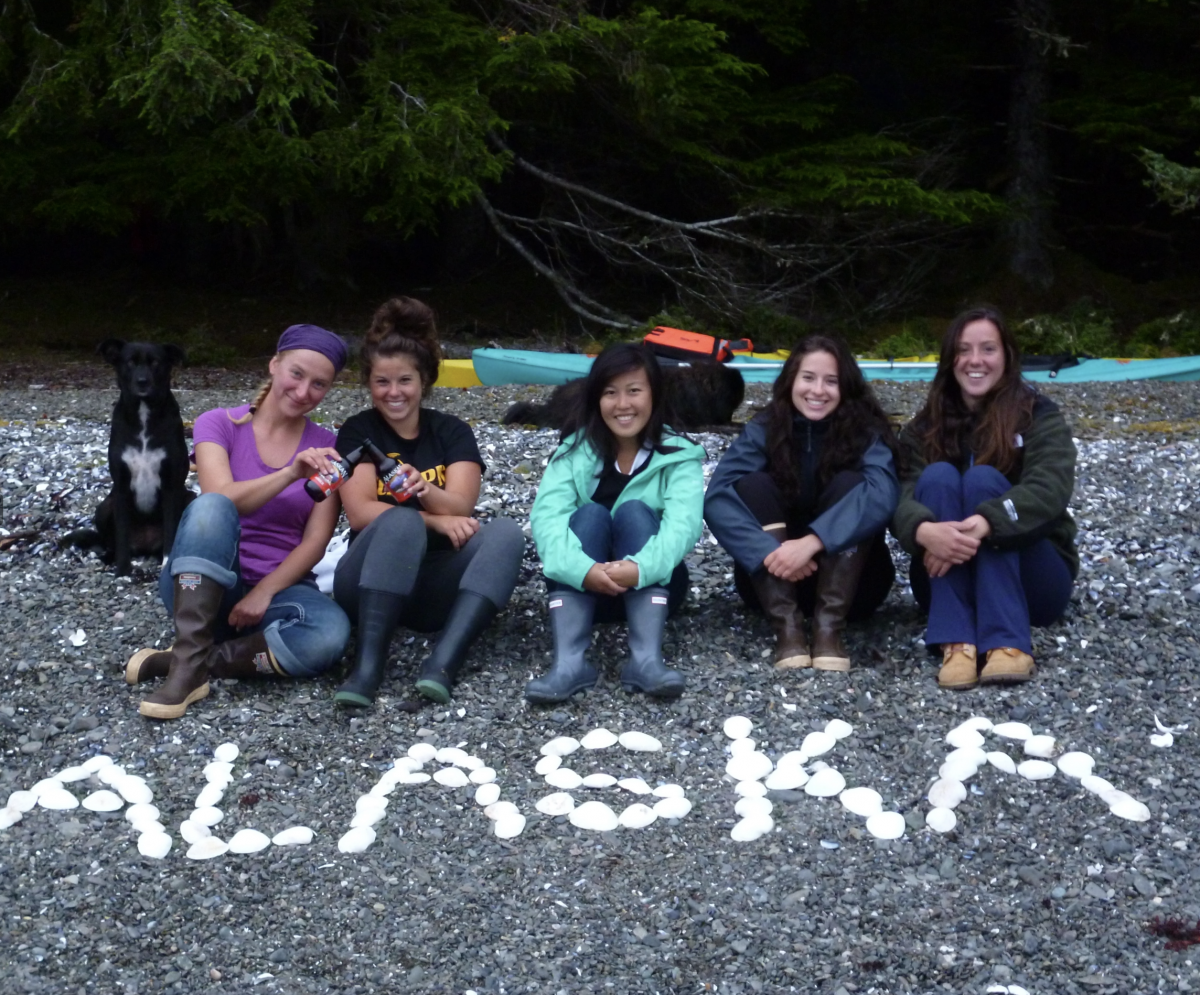
"Some of the feedback that I’ve gotten about the film has been from young women, between the ages of 16 and 25, who said, 'I watched this film, and it was the first time that I felt I was allowed to be a part of science.'"
Research at UNH
About the Sound Science Research Collective
![]() The Sound Science Research Collective is a federally recognized 501c(3) marine conservation nonprofit dedicated to excellence in research and equity in science. It’s made up of a team of bio-acousticians and ecologists from throughout the United States dedicated to the common goal of driving impactful ecological research and empowering overlooked and disenfranchised scientists to do the same. Learn more.
The Sound Science Research Collective is a federally recognized 501c(3) marine conservation nonprofit dedicated to excellence in research and equity in science. It’s made up of a team of bio-acousticians and ecologists from throughout the United States dedicated to the common goal of driving impactful ecological research and empowering overlooked and disenfranchised scientists to do the same. Learn more.
Before joining COLSA as a visiting professor, Fournet completed her postdoctoral research at the K. Lisa Yang Center for Conservation Bioacoustics in the Cornell Lab of Ornithology. In addition to her posts at UNH, she serves as director of the nonprofit Sound Science Research Collective, which she co-launched in 2018 with some of her colleagues in the bioacoustics field.
Having researched bioacoustics for more than a decade, Fournet has studied a variety of animals during her work, including toadfish in the Florida Everglades and sea trout, snapping shrimp, harbor seals, killer whales and bowhead whales in the ocean. At UNH, her research will focus on bearded seals and the impact that climate change has had on this species — the largest seal species in the Arctic — and how they communicate and call to one another. She’ll work with Inupiat community groups in Northern Alaska to determine strategies for bearded seal conservation and to identify — through a collaborative effort — other climate change-related issues affecting indigenous villages located both above and below the Arctic Circle. As part of this research, she’ll be listening to bearded seals off the coast of Utqiagvik (formerly called Barrow, Alaska), one of the northernmost towns in the United States.
"I’ll be investigating the cumulative impacts of a reduction of sea ice associated with climate change and an elevation in anthropogenic noise associated with more boats making their way to the Arctic," says Fournet.
Bearded seals are especially threatened by climate change because they rely on sound to find mates and to defend their territories. They depend on sea ice to rest, sleep and give birth. Warmer ocean waters result in less sea ice, which creates more open water for boats to encroach on bearded seal territories, describes Fournet. All of this results in both smaller territories for bearded seals and noisier environments. In addition to her work in Northern Alaska, she’ll also be studying breeding calls to help determine what has happened to bearded seal populations that once lived and thrived near the Yup’ik villiage of Togiak, Alaska, a community situated well below the Arctic Circle.
Bearded seals are especially threatened by climate change because they rely on sound to find mates and to defend their territories. They depend on sea ice to rest, sleep and give birth.
"In an area where we used to have ice, now there is snow,” says Fournet, “and there used to be a breeding population of bearded seals there. The question that the community in Togiak has asked me to answer is, ‘Have our seals left us? Have they abandoned this area?’ And we’re going to use sound to figure that out."
Bearded seals are very vocal, adds Fournet. Fournet and her collaborators will use hydrophones to determine if the seal population that once lived near Togiak has entirely left the area or moved to a new location within Bristol Bay, Alaska, and started arriving at different times of the year.
Fournet will also continue her studies of humpback whale calls in Southeast Alaska, examining changes in whale calling before, during and following the pandemic. And she’s looking forward to returning to field research in Alaska this June for the first time in nearly two years.
Impact of the Pandemic on Marine Acoustic Research
For Fournet, 2019 ended up being the last season she spent in-person in Alaska. However, her research there has continued with remote monitoring of hydrophones and the categorizing of humpback whale calls, and it’s produced some especially interesting results. For starters, the significantly reduced boat and cruise ship traffic in the region (due to the pandemic) has allowed Fournet and her colleagues to hear different, more complex whale calls. This is largely the result of a change in behavior of the humpbacks. Prior to the pandemic, Fournet and her colleagues learned that humpback whales will actually call less often or stop calling altogether to another when the ocean is noiser, for example, when a loud cruise ship passes by. Once the boat passes, they’ll resume their calls.
"What we found in Alaska is that the ocean got significantly quieter during the pandemic, and we were able to record things that we’ve never recorded before," describes Fournet. "There are humpback whale call types that we recorded in Southeast Alaska in 2020 that had never been described before."
Fournet describes the change in call types like speaking to a person in a quiet setting versus in a noisy space. In a quieter, more intimate environment, the two speakers can easily hear each other and carry on a conversation with complete sentences. In a louder environment, for example, at a live music performance, two people speaking will likely use shorter sentences, speak much louder and project more, to be heard above the loudness of the music. Fournet and her fellow researchers found the same was true for humpbacks in Southeast Alaska: how they communicated changed in a quieter environment.
"In the absence of vessels, they called more often, we heard more call types and we found that the complexity of their acoustic interactions increased," she adds.
"In the absence of vessels, they called more often, we heard more call types and we found that the complexity of their acoustic interactions increased"
In mid-June, Fournet will return to Alaska for the first time since that 2019 field research season featured in Fathom. It’s been challenging to be away for so long from a place where she lived full-time for seven years and, outside of living there, has regularly visited several times a year to listen to and study the marine life.
“This is the longest stretch of time that I’ve gone without being in Alaska since I moved there in 2007,” she says. “This field season [2022] is going to be pretty precious to me, to be able to get back and see my friends, see my community, be back to being part of my ecological community and to see the animals that I haven’t been able to interact with since the pandemic began.”
You can watch Fathom on Apple TV+. You can find additional Humpback whale calls and other wildlife calls on Fournet's SoundCloud webpage.
-
Written By:
Nicholas Gosling '06 | COLSA/NH Agricultural Experiment Station | nicholas.gosling@unh.edu


















































